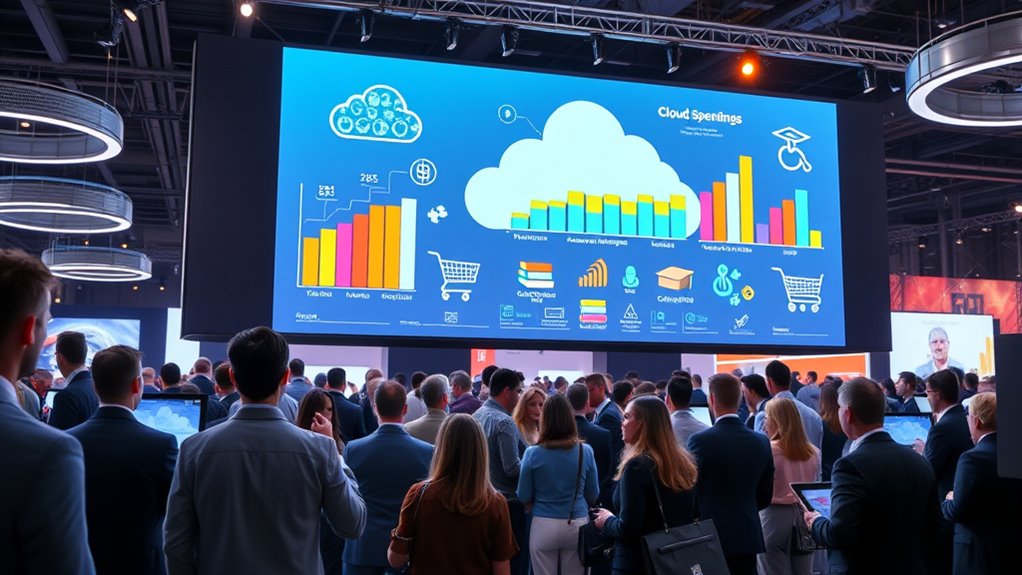Sector-specific cloud spending varies greatly, driven by unique needs and regulatory demands. Healthcare invests heavily in digital health tech and security, boosting cloud use for data and AI-driven diagnostics. Finance favors private clouds for security and compliance, while education leverages cloud tools for remote learning and research. Manufacturing focuses on real-time data from IoT sensors, and retail relies on cloud for e-commerce growth and customer insights. Exploring these differences reveals how each sector drives cloud innovations—stay tuned for more in-depth details.
Key Takeaways
- Healthcare cloud spending is driven by digital health tech, telemedicine, AI integration, and remote patient monitoring, projected to reach USD 276 billion by early 2030s.
- Financial sector invests heavily in private and hybrid clouds for security, compliance, real-time insights, and AI-driven risk management solutions.
- Education increasingly adopts cloud for AI tools, remote learning, data storage, and security compliance like FERPA, supporting personalized and collaborative learning environments.
- Manufacturing leverages cloud for IoT data, digital twins, real-time analytics, and hybrid architectures to enhance operational resilience and intellectual property security.
- Retail focuses on cloud-based e-commerce, omnichannel experiences, customer data insights, and security measures to protect payment information and ensure PCI DSS compliance.
Healthcare Cloud Computing Market Dynamics and Growth Drivers

The healthcare cloud computing market is experiencing rapid growth driven by the increasing adoption of digital health technologies and stringent regulatory requirements. As you integrate electronic health records (EHR), telemedicine, and remote monitoring tools, cloud solutions become essential for managing this data securely and efficiently. Regulatory compliance, especially HIPAA, encourages healthcare providers to adopt private and hybrid clouds to protect sensitive information. Advances in AI and machine learning embedded in cloud platforms improve diagnostics and personalize treatments, further boosting adoption. The rise in patient data from wearables and sensors fuels demand for scalable, remote-enabled cloud services. COVID-19 accelerated this shift, emphasizing the need for remote care and operational continuity. Overall, these drivers fuel a market projected to reach up to USD 276 billion by the early 2030s. Incorporating risk management strategies and diversifying cloud services are also critical for maintaining security and compliance in this rapidly evolving landscape. Additionally, security considerations are paramount as the volume of sensitive health data grows, necessitating robust protective measures. The increasing volume of sensitive health data underscores the importance of implementing comprehensive security measures to mitigate potential breaches and ensure data integrity. Furthermore, the integration of patient data management solutions helps streamline workflows and enhances overall healthcare delivery.
Financial Sector’s Adoption of Private Cloud and Compliance Strategies

You’re likely aware that financial institutions prioritize private cloud solutions to strengthen security and meet strict regulatory requirements. These organizations implement specific compliance strategies, such as identity management and workload segregation, to reduce risks and guarantee data privacy. By adopting private clouds, they gain benefits like better control, cost savings, and enhanced ability to adapt to evolving regulations. Many also leverage security protocols to ensure data integrity and prevent breaches.
Security Enhancement Measures
Financial institutions are increasingly turning to private cloud infrastructure to bolster their security measures and guarantee compliance. Private cloud provides data locality features, enabling strict access controls and reducing cybersecurity threats. Automated encryption and real-time monitoring strengthen protection against breaches and unauthorized access. Hosted private clouds isolate critical applications from multi-tenant risks, creating high-performance, compliant environments. Software-defined infrastructure improves segmentation and cuts attack surfaces by dynamically managing network and compute resources. Institutions leverage private cloud to enable continuous security posture assessments, allowing rapid threat detection and response. AI integration further enhances security by detecting anomalies, automating incident responses, and improving identity management. Additionally, AI’s real-time monitoring capabilities enhance threat detection and enable adaptive security measures tailored to evolving cyber threats. The use of hydrocolloid technology in various industries exemplifies the importance of innovative materials in promoting healing and reducing irritation. Incorporating security best practices such as regular updates and staff training is also vital to maintaining a robust security framework. As a result, private cloud adoption supports advanced security controls tailored to financial data, reducing risks without sacrificing operational efficiency.
Regulatory Compliance Strategies
How are financial institutions steering the complex landscape of regulatory compliance when adopting private cloud solutions? They leverage strategies like hybrid and multi-cloud approaches—59% and 56% respectively—to meet strict regulations. Working with locally owned vendors—35% of firms—helps guarantee compliance with region-specific rules. To maintain control, 37% limit the data stored in the cloud, emphasizing data governance through private cloud deployment. Addressing cross-border challenges, institutions must navigate GDPR and other regulations, standardize data formats, and stay updated on evolving rules. Managing vendor risks involves thorough risk assessments and contractual protections. Collaboration with regulators and industry stakeholders ensures frameworks are effective, enabling institutions to balance cloud benefits with compliance demands. Incorporating sound regulatory compliance strategies can further streamline cloud adoption processes.
Private Cloud Benefits
Adopting private cloud solutions offers the financial sector significant advantages in security, control, and compliance. With 88% of financial firms expected to use cloud platforms by 2025, private clouds are essential for safeguarding sensitive data. They provide superior control over data, ensuring compliance with complex regulations through data locality, transparency, and governance. Private clouds also enhance disaster recovery and risk mitigation, fundamental for operational resilience. They enable automated encryption and tailored access controls, streamlining security management. Cost visibility improves as private clouds consolidate legacy systems and modern workloads, reducing operational complexity. Additionally, private clouds support AI and innovative financial products, facilitating rapid development while maintaining regulatory compliance. Understanding spiritual energy and its influence can help organizations cultivate resilience and emotional well-being within their teams, fostering a healthier work environment. Recognizing the importance of cloud scalability is crucial for accommodating future growth and technological advancements. The integration of cloud management tools further optimizes resource allocation and operational efficiency. As the sector grows, private clouds will continue to be indispensable for scalability, security, and future-proofing.
Educational Institutions Leveraging Cloud for Digital Transformation

Educational institutions are increasingly harnessing cloud technologies to drive their digital transformation efforts. This shift enables better scalability, cost savings, and remote learning capabilities. You’ll find that cloud-based learning management systems (LMS) and student information systems (SIS) are rapidly gaining popularity, supporting personalized and hybrid learning models. Major vendors like Instructure and Ellucian foster innovation through strategic partnerships. Benefits include:
Educational institutions leverage cloud tech for scalable, cost-effective, and flexible remote learning solutions.
- Improved agility and operational efficiency
- Enhanced scalability and storage options
- Support for remote and hybrid learning environments
- Adoption of managed cloud services for streamlined management
- Reduced staffing needs through cloud migration
Despite these advantages, security concerns and lack of in-house skills remain hurdles. Still, the market is projected to grow remarkably, with increased AI integration and remote learning expansion shaping the future of education. Furthermore, understanding nanotechnology developments can open new avenues for innovative educational tools and research capabilities. For instance, integrating cloud-based storage solutions can facilitate seamless access to large datasets in educational research, enhancing collaboration and innovation.
Manufacturing’s Shift Toward Real-Time Data and IoT Integration

Manufacturers are increasingly leveraging cloud technology to access and analyze real-time data from IoT sensors, transforming their operations. This shift enables instant decision-making, predictive maintenance, and better visibility across supply chains. Cloud platforms centralize data from diverse sources, reducing latency and streamlining responses. Edge computing complements this by preprocessing data locally, lowering bandwidth costs and improving reaction times. Hybrid cloud architectures balance on-premises processing with scalable cloud resources for global operations. The adoption of digital twins powered by cloud data allows for continuous simulation and optimization, reducing downtime and enhancing product design. With cloud-driven analytics, manufacturers can quickly identify risks and disruptions, ensuring resilience. This rapid data integration accelerates innovation and operational agility across manufacturing processes. Additionally, understanding aviation regulations helps ensure compliance as manufacturers adopt these advanced cloud strategies. Recognizing the importance of cloud security further safeguards sensitive information and maintains trust in digital transformation efforts. Furthermore, integrating personal development principles such as goal setting and self-reflection can foster a more innovative and adaptable workforce capable of navigating these technological changes. Emphasizing training and education ensures employees are equipped to manage and optimize these new systems effectively.
Retail Industry’s Use of Cloud for E-commerce and Omnichannel Experiences

The retail industry is rapidly advancing its digital capabilities by leveraging cloud technology to enhance e-commerce platforms and deliver seamless omnichannel experiences. Cloud adoption helps you scale during peak seasons, improve customer interactions, and secure sensitive data. With cloud-based e-commerce, you can support mobile shopping and integrate social media tools to boost engagement. Cloud-driven analytics enable real-time insights into customer behaviors, allowing personalized marketing and targeted campaigns. Additionally, cloud solutions streamline inventory management and supply chain operations, ensuring efficiency and responsiveness. Cloud services from providers like AWS, Azure, and Google Cloud support your infrastructure needs. You can also optimize costs, implement disaster recovery plans, and connect on-premises systems with cloud environments. These innovations help you stay competitive in a rapidly evolving retail landscape.
Leveraging cloud technology transforms retail with scalable platforms, real-time insights, and seamless omnichannel customer experiences.
- Scalable e-commerce platforms for peak seasons
- Seamless integration across channels
- Real-time customer data insights
- Secure, cloud-based payment processing
- Inventory and supply chain optimization
Cross-Industry Trends Shaping Cloud Spending and Technological Innovation

You’re seeing how AI-driven data analysis is pushing cloud investments across various industries, fueling innovation and efficiency. At the same time, rising cybersecurity challenges demand increased spending on security measures and compliance tools. These trends are shaping how organizations allocate their cloud budgets to stay competitive and secure in a rapidly evolving digital landscape. Additionally, organizations are increasingly adopting encryption solutions to safeguard sensitive data and ensure secure communication across platforms. As part of comprehensive security strategies, implementing robust access controls is becoming essential to prevent unauthorized data breaches and protect organizational assets. Incorporating security best practices into cloud management is also crucial for maintaining compliance and safeguarding organizational reputation. Understanding environmental considerations is also vital, ensuring sustainable and responsible cloud usage that aligns with ecological best practices.
AI-Driven Data Analysis
AI-driven data analysis is transforming cloud spending across industries by enabling more advanced, scalable, and real-time insights. This shift supports sectors like healthcare, finance, education, manufacturing, and retail in leveraging data for strategic advantage. You’ll see increased investments in generative AI, which 63% of companies adopt to fuel innovation. Cloud infrastructure is crucial, with revenues expected to surpass $400 billion by 2025. Cross-industry adoption is growing, with nearly 65% of organizations exploring AI technologies. Additionally, innovations like automated data processing, NLP, data mesh architecture, edge computing, and sophisticated forecasting are reshaping how data is managed and analyzed. These developments make cloud platforms indispensable for extracting actionable insights, improving efficiency, and driving competitive differentiation across sectors. Moreover, predictive analytics is increasingly integrated into cloud solutions, enabling organizations to proactively anticipate trends and optimize operations. The adoption of specialized cloud solutions tailored to industry-specific needs further accelerates this transformation, ensuring that each sector maximizes its data potential.
Cybersecurity Challenges
As cloud adoption accelerates across industries, cybersecurity challenges become more complex and pressing. You face rising threats like misconfigured storage, which cause 68% of breaches, and a surge in cryptojacking incidents. Sensitive data stored in the cloud increases to 54%, demanding stronger encryption and access controls. Hybrid and multi-cloud environments, used by 87% of enterprises, complicate security management, creating inconsistent policies and visibility gaps. Third-party vulnerabilities remain a major concern, with 62% of organizations affected by supply chain breaches. Limited cybersecurity talent and constrained budgets hinder effective protection, leaving gaps in threat detection and incident response. As you invest more in cloud security—projected to surpass $19.7 billion by 2025—you must prioritize holistic risk management and adaptive security strategies to stay ahead of evolving threats. Enhanced understanding of cybersecurity vulnerabilities is essential for developing resilient defenses. Recognizing the importance of industry-specific cloud security can help tailor protective measures to your sector’s unique needs. Additionally, adopting comprehensive security frameworks can improve your ability to manage complex cloud environments effectively.
Frequently Asked Questions
How Do Sector-Specific Regulations Influence Cloud Security Measures?
Sector-specific regulations directly shape your cloud security measures by setting strict compliance standards you must follow. These rules require you to implement tailored controls like encryption, access management, and continuous monitoring. Failing to meet these standards risks hefty fines and legal issues. So, you need to adopt security practices aligned with your sector’s regulations, ensuring your cloud environment remains compliant, secure, and trustworthy for your data and stakeholders.
What Are the Key Challenges in Integrating AI Across Different Industries?
You face a complex landscape when integrating AI across industries. Data silos and legacy systems act as subtle barriers, making seamless connections challenging. Workforce skills gaps and unclear strategies further slow progress. Additionally, steering regulatory and ethical waters requires careful planning. Overcoming these hurdles demands strong leadership, clear governance, and robust technical solutions to unleash AI’s full potential and drive meaningful innovation in your organization.
How Does Cloud Adoption Impact Data Privacy Concerns in Each Sector?
You need to recognize that cloud adoption heightens data privacy concerns across sectors. In healthcare, you face strict regulations like HIPAA, making security essential. Finance demands transparency to maintain trust amidst cyber threats. Education involves safeguarding student data under FERPA and COPPA, while manufacturing and retail must protect sensitive info from breaches. By implementing robust security measures and compliance tools, you can mitigate privacy risks and build confidence in cloud solutions.
What Role Do Emerging Technologies Like Blockchain Play in Sector-Specific Clouds?
Emerging technologies like blockchain revolutionize sector-specific clouds by enhancing security and transparency. You benefit from immutable audit trails, decentralized identity management, and smart contracts that automate security policies. Unlike traditional systems, blockchain reduces risks of data tampering and unauthorized access, giving you greater control and trust. Its decentralized nature also minimizes single points of failure, improving system robustness. Overall, blockchain empowers sectors with secure, transparent, and efficient cloud solutions.
How Are Sustainability Goals Incorporated Into Cloud Strategies Across Industries?
You incorporate sustainability goals into your cloud strategies by choosing energy-efficient infrastructure, investing in renewable energy sources, and optimizing resource use. You adopt cloud-based tools that reduce physical hardware needs, cut down waste, and lower carbon emissions. Additionally, you leverage real-time analytics to improve operational efficiency, promote virtual collaboration, and implement green IT policies, ensuring your cloud initiatives align with your environmental sustainability commitments across various industries.
Conclusion
As you navigate the evolving cloud landscape, remember it’s a symphony where each industry plays its unique tune. From healthcare’s life-saving data to retail’s seamless shopping experience, cloud spending fuels innovation across sectors. Embrace these shifts, and you’ll see how cloud technology acts as the backbone, connecting the dots like stars in a constellation. Staying ahead means riding this wave of change—because in the world of cloud, adaptation isn’t just smart, it’s essential.









